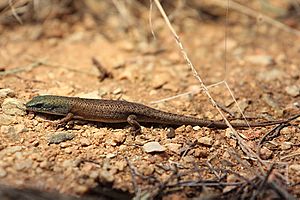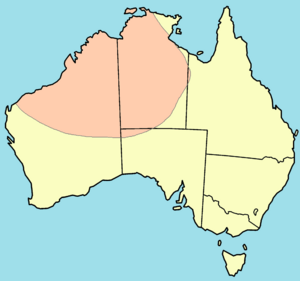Desert rainbow-skink facts for kids
Quick facts for kids Desert rainbow-skink |
|
|---|---|
 |
|
| Male | |
| Conservation status | |
| Scientific classification | |
| Genus: |
Carlia
|
| Species: |
triacantha
|
 |
|
The desert rainbow-skink (Carlia triacantha) is a small lizard found in Australia. It belongs to a group of lizards called skinks. These skinks are often called "four-fingered skinks." You can find them in the dry woodland areas of the Northern Territory, northern Western Australia, and the far north-west of South Australia. This skink was first named Leiolopisma triacantha. Sometimes, people also call it the three-spined rainbow-skink.
What Does the Desert Rainbow-Skink Look Like?
The desert rainbow-skink is about 5.3 centimetres (2.1 in) long, not counting its tail. A special feature of this skink is that it has three small ridges, or "spines," on its back scales. Its body is usually a mid-brown or grey-brown color. Its belly is lighter in color. Male skinks show more bright colors, especially when it's time to find a mate.
Desert rainbow-skinks like to hide in the leaf litter found in woodland areas. They mostly eat small invertebrates, which are creatures without backbones. Their large eyes help them see their prey in the dim light under the leaves. Their eyes also have a special eyelid with a clear window. This protects their eyes when they burrow through the leaf litter.
How Do Desert Rainbow-Skinks Reproduce?
The desert rainbow-skink is a reptile that lays eggs. This means it is an oviparous animal. On average, a female skink lays two eggs at a time. This group of eggs is called a clutch. During the breeding season, male skinks become very colorful. Their heads turn blue-green, and their sides become red.


